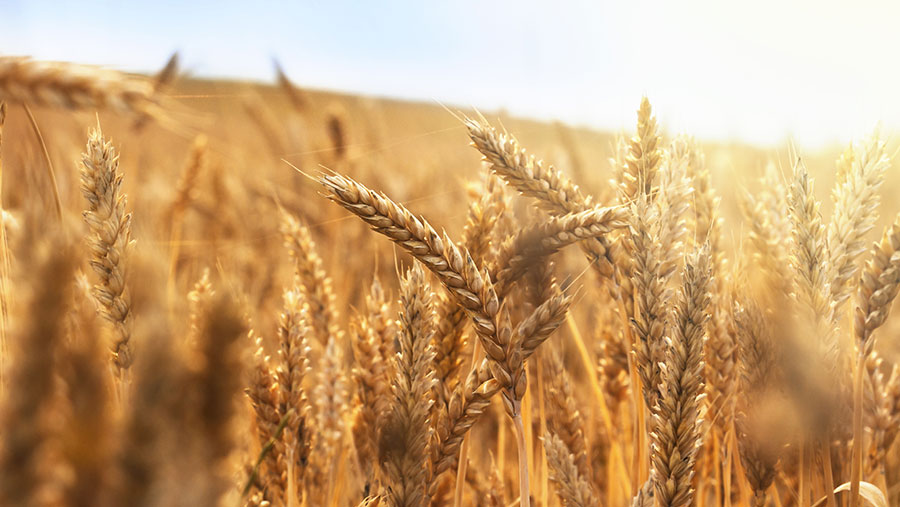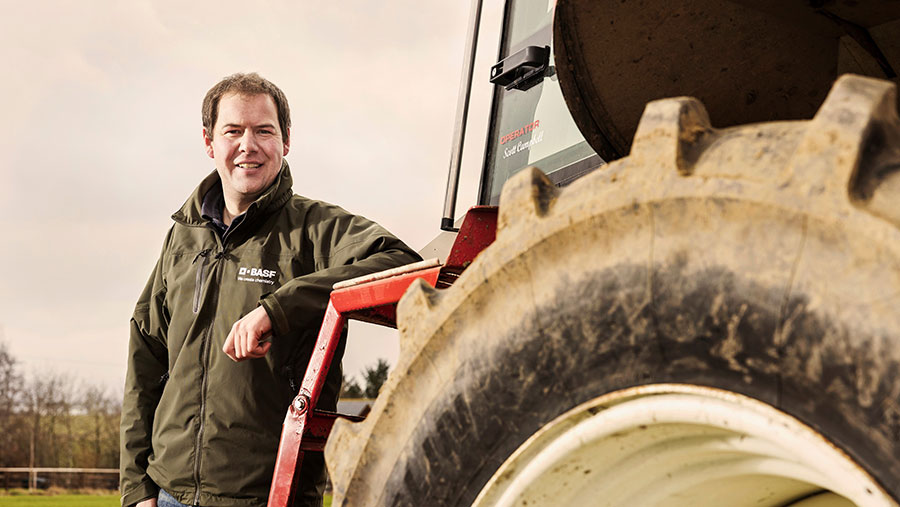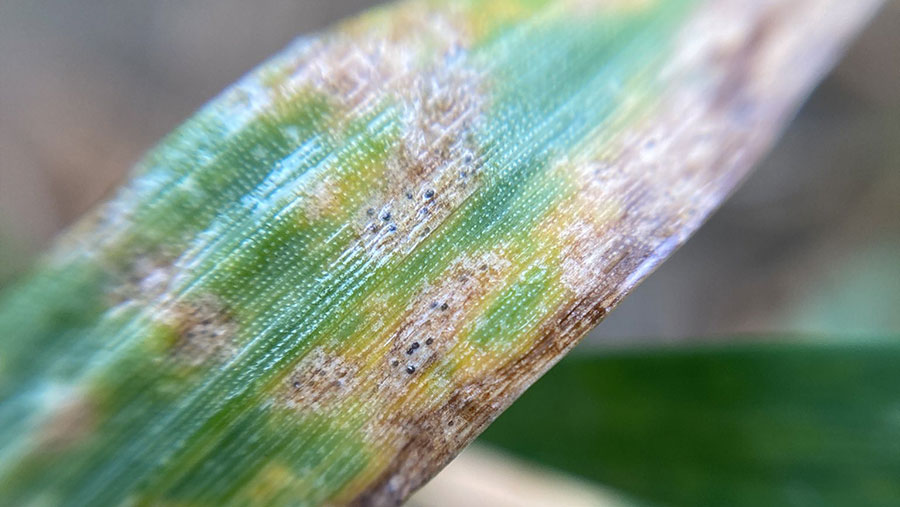Advertiser content
Growing resilient wheat: Insight into a grower’s approach
 © BASF
© BASF Scott Campbell farms in partnership with his father and uncle at Kirkton of Kinellar, the main unit of their 415-ha arable enterprise in Aberdeenshire.
Winner of the Farmers Weekly Arable Farmer of the Year in 2019, Scott’s attention to detail, along with his willingness to put time and effort into trialling new products and ideas, are second to none, and recent findings from tramline trials will lead to refinements in his winter wheat fungicide programme this season.
Winter wheat establishment
Winter wheat crops are mucked at least once every four years with either muck or digestate.
Drains are kept maintained and parts are being upgraded to ensure the foundations are right to deal with increased rainfall.
Regular soil testing ensures pH and indices of macro and micronutrients are suitable for crop growth, with leaf testing also used to identify potential deficiencies.
Scott said: “We are trying some back-end cover crops to keep nutrients in the soil on land destined for spring crops. This season we have some forage rye mixed with oil radish.
“The plan was to have a young farmer put his sheep on to graze them, but unfortunately it has been too wet for that to happen.”
Establishment of winter wheat is equally divided between the plough and a min-till system.
Scott said: “We find the min-till system is helpful in reducing soil erosion and uses half the fuel and labour that ploughing does, so it is quicker and cheaper. I would like to do more but you have to watch the weeds.
“We are always mindful not to let brome or large populations of annual meadow grass get in; you don’t want to take your mechanical costs down and put your herbicide costs up”.

Scott Campbell © BASF
Grazing trial
Scott is very keen on helping the next generation of growers and regularly hosts student visits from SRUC Craibstone.
As well as giving young farmers the opportunity to graze their flock on his cover crops, last year he carried out a trial where half a field of winter wheat was grazed.
Scott said: “The yield was the same on both the grazed and ungrazed areas, with savings on plant growth regulators (PGRs) and on T0 fungicide in the grazed area.
“However, a section of the grazed area suffered from frost heave so there is a risk but if you have the right conditions and the right strategy then it has potential.”
Variety selection and disease management
For Scott, the starting point when managing disease is variety. Scott decided not to grow LG Skyscraper this season.
He said: “It is a variety that has served us well with high yields, but its Septoria rating is relatively low at 4.9 and KWS Dawsum, which we are now growing, is 1.5 points above that.”
This year Scott has five varieties in the ground, which he feels helps to spread the risk.
As well as KWS Dawsum, he is growing SY Insitor, RGT Bairstow, KWS Colosseum, which did well when he grew it for the first time last year, and Bamford for seed.
“Septoria is our main concern here as our climate produces an annual average rainfall of 870mm, although it will be much higher than that this year.
“Our winter wheats are sown early, and we were very fortunate to have the crops drilled before we got the bad weather in October. Although that leads to increased disease pressure, I’m confident we have the fungicides to deal with that. If needed, I’ll apply a cheap T0 to damp down disease and then follow this with a decent T1.

Septoria on wheat © BASF
“Revysol® has definitely got to be included in our fungicide programme.
“It gives us flexibility in the spray programme as we can use it at T1 and T2, and has shown us over a number of years now that it keeps our crops greener and cleaner for longer.”
Tramline trials
Scott has been involved with BASF’s Real Results Circle for over four years, conducting trials and enjoying the interaction with like-minded farmers.
“Doing a tramline trial with a product makes my job far more interesting, and it is a great initiative to be part of.
“Having the opportunity to trial a product on your farm and in your soil, in fields that you know, makes it relevant.”
Last year, his trial was in a field of KWS Dawsum, min-tilled after oilseed rape, which investigated the effects of increasing the rate of Revystar® XE (Revysol® + Xemium®) at T2, with the whole trial site receiving the same farm standard programme at T0, T1 and T3.
Three tramline treatments were carried out at T2, applied on the 6th of June, each with a different rate of Revystar® XE: – 1.0 l/ha, 1.25 I/ha and 1.5 l/ha.
Towards the end of the season, as the crop senesced in July, normalised difference vegetation index (NDVI) appeared slightly lower in the Revystar® XE 1.0 l/ha treatment, suggesting that the higher Revystar® XE doses improved green canopy duration.
Disease levels were also assessed in mid-July, with septoria present on all leaf layers, but no other diseases observed.
On the flag leaves, green leaf area (GLA) increased significantly with Revystar® XE dose. However, there were no significant differences between treatments in septoria severity.
When it came to harvest, the farm standard of 1.0 l/ha yielded 12.52 t/ha, the 1.25 l/ha treatment 12.96 t/ha and the 1.5 l/ha treatment 13.06 t/ha.

© BASF
In terms of yield, Scott said: “On a clean variety like KWS Dawsum, which has a septoria resistance rating of 6.4, I wasn’t expecting to see such a big jump in yield from the farm standard rate of 1.0 l/ha.
“There were yield increases with both the 1.25 l/ha and the 1.5 l/ha rate, which was quite impressive. There was almost half a tonne of yield uplift from stepping up from the 1.0 l/ha to the 1.25 l/ha.
“Calculating the margin, taking a wheat price of £200/t for last season, we were £73/ha better off, including the extra spend on the fungicide, applying 1.25 l/ha compared to 1.0 l/ha of Revystar XE.
“This dose gave the best margin difference. You have to be careful not to get a better yield at the expense of the margin but I’ve done the calculations at today’s price, and the 1.25 l/ha would still deliver the best return. Margin is king.
“Taking what we have learnt from this trial, my advice for this challenging season would be, on well established crops, assess the disease then up the rates on the bits where you are sure to get the return.
“I know it’s an early call but I think we will use 1.2 l/ha of Revystar XE on the best established bits of crops – the ones that we will be pushing to get 11 to 12 t/ha.”
For more information on Revystar® XE, please visit our website.
Provided by
BASF offers renowned and innovative fungicides, herbicides, insecticides and growth regulators for agriculture. Our products and services help farmers increase their yields and optimize the quality of their products.
